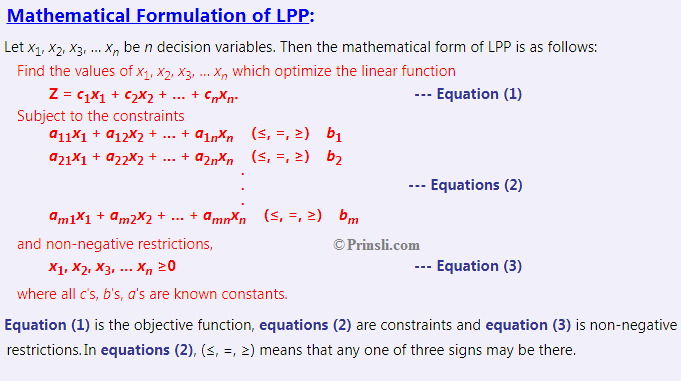
Classification of Modelling in Operations Research:
Models in Operations Research can be classified according to the following characteristics:
1. Classification of Modelling by Structure:
i). Iconic models.
What are iconic models? An Iconic model represents the system as it is by scaling it up or down (i.e., by enlarging or reducing the size). In other words, it is an image.
For example, a toy aeroplane is an iconic model of a real one. Other common examples of iconic models are photographs, drawings, maps etc. A model of an atom is scaled up so as to make it visible to the naked eye. In a globe, the diameter of the earth is scaled down, but the globe has approximately the same shape as the earth, and the relative sizes of continents, seas, etc., are approximately correct.
The iconic model is usually the simplest to conceive and the most specific and concrete. Its function is generally descriptive rather than explanatory. Accordingly, it cannot be easily used to determine or predict what effects many important changes on the actual system.
ii). Analogue models.
What is the analog model in operation research? The models, in which one set of properties is used to represent another set of properties, are called analogue models. After the problem is solved, the solution is reinterpreted in terms of the original system.
Examples of analogue models – Graphs, for example, are very simple analogues because the distance is used to represent the properties such as time, number, percent, age, weight, and many other properties. Contour lines on a map represent the rise and fall of the heights. In general, analogues are less specific, less concrete but easier to manipulate than our iconic models.
iii). Symbolic (Mathematical) models.
The symbolic or mathematical model is one that employs a set of mathematical symbols (i.e., letters, numbers, etc.) to represent the decision variables of the system. These variables are related together by means of a mathematical equation or a set of equations to describe the behaviour (or properties) of the system. The solution to the problem is then obtained by applying well-developed mathematical techniques to the model.
The symbolic model is usually the easiest to manipulate experimentally and it is most general and abstract. Its function is more often explanatory rather than descriptive.
Read More: Models and Modelling in operations research
2. Classification of Modelling in Operations Research by Purpose:
Models can also be classified by the purpose of their utility. The purpose of a model may be descriptive predictive or prescriptive.
i). Descriptive models.
A descriptive model simply describes some aspects of a situation based on observations, surveys, questionnaire results or other available data. The result of an opinion poll represents a descriptive model.
ii). Predictive models.
Such models can answer ‘what if’ type of questions, i.e. they can make predictions regarding certain events. For example, based on the survey results, television networks such models attempt to explain and predict the election results before all the votes are actually counted.
iii). Prescriptive models.
Finally, when a predictive model has been repeatedly successful, it can be used to prescribe a source of action. For example, linear programming is a prescriptive (or normative) model because it prescribes what the managers ought to do.
3. Classification of Modelling by Nature of Environment:
These are mainly of two types:
i). Deterministic models.
Such models assume conditions of complete certainty and perfect knowledge. For example, linear programming, transportation and assignment models are the deterministic types of models.
ii). Probabilistic (or Stochastic) models.
These types of models usually handle such situations in which the consequences or payoff of managerial actions cannot be predicted with certainty. However, it is possible to forecast a pattern of events, based on which managerial decisions can be made. For example, insurance companies are willing to insure against the risk of fire, accidents, sickness and so on, because the pattern of events has been compiled in the form of probability distributions.
4. Classification of Modelling in Operations Research by Behavior:
i). Static models.
These models do not consider the impact of changes that takes place during the planning horizon, i.e. they are independent of time. Also, in a static model, only one decision is needed for the duration of a given time period.
ii). Dynamic models.
In these models, time is considered as one of the important variables and admits the impact of changes generated by time. Also, in dynamic models, not only one but a series of ‘interdependent’ decisions is required during the planning horizon.
5. Classification of Modelling by Method of Solution:
i). Analytical models.
These models have a specific mathematical structure and thus can be solved by known analytical or mathematical techniques. For example, a general linear programming model, as well as the specially structured transportation and assignment models are analytical models.
ii). Simulation models.
They also have a mathematical structure but they cannot be solved by purely using the ‘tools’ and ‘techniques’ of mathematics. A simulation model is essentially computer-assisted experimentation on a mathematical structure of a real-time structure in order to study the system under a variety of assumptions.
Simulation modelling has the advantage of being more flexible than mathematical modelling and hence can be used to represent complex systems that otherwise cannot be formulated mathematically. On the other hand, simulation has the disadvantage of not providing general solutions like those obtained from successful mathematical models.
6. Classification of Modelling by Use of Digital Computers:
The development of the digital computer has led to the introduction of the following types of modelling in OR.
i). Analogue and Mathematical models combine:
Sometimes analogue models are also expressed in terms of mathematical symbols. Such models may belong to both the types (ii) and (iii) in classification 1 above.
For example, a Simulation model is of analogue type but mathematical formulae are also used in it. Managers very frequently use this model to ‘simulate’ their decisions by summarizing the activities of the industry in a scale-down period.
ii). Function models:
Such models are grouped on the basis of the function being performed.
For example, a function may serve to acquaint scientists with such things as tables, carrying data, a blueprint of layouts, a program representing a sequence of operations (like in computer programming).
iii). Quantitative models:
Such models are used to measure the observations.
For example, degree of temperature, yardstick, a unit of measurement of length value, etc.
Other examples of quantitative models are (i) transformation models which are useful in converting a measurement of one scale to another (e.g., Centigrade vs. Fahrenheit conversion scale), and (ii) the test models that act as ‘standards’ against which measurements are compared (e.g., business dealings, a specified standard production control, the quality of a medicine).
iv). Heuristic models.
These models are mainly used to explore alternative strategies (courses of action) that were overlooked previously, whereas mathematical models are used to represent systems possessing well-defined strategies. Heuristic models do not claim to find the best solution to the problem.
(Source – Various books of college library)
Tags: What are the classification of models in operations research?
Copyrighted Material © 2019 - 2024 Prinsli.com - All rights reserved
All content on this website is copyrighted. It is prohibited to copy, publish or distribute the content and images of this website through any website, book, newspaper, software, videos, YouTube Channel or any other medium without written permission. You are not authorized to alter, obscure or remove any proprietary information, copyright or logo from this Website in any way. If any of these rules are violated, it will be strongly protested and legal action will be taken.




bibliography… Actually, I don’t remember. I had used my college library to make notes for my students
Where is your consulted bibliography?
Nice piece
Hello friend
Please help me grow my blog by clicking to follow my site
Am new in blogging
Am planning to blog full time on Christian relationship matters
Thank you